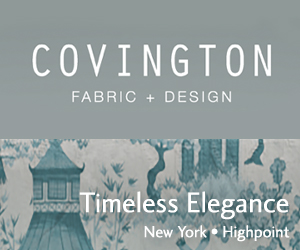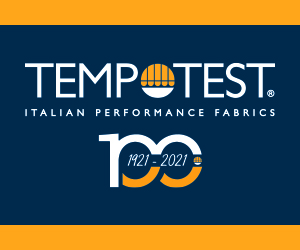Protect Your Proprietary Design Rights When Sourcing Abroad
April 3, 2001
Attorney Urges Maintenance of Ownership Records and Membership in Design Protection Organizations
New York – There may be many advantages to sourcing globally. Price advantages and specific product offerings may be available in foreign markets that would not otherwise be obtainable, and distribution arrangements to export customers may be eased when products are delivered directly from a foreign source. Certain disadvantages, however, also exist. One, which is the subject of this article, is the ability of firms to protect their proprietary rights in original, independently created designs in foreign markets.
THE PROBLEM
For many firms in the home textile industry, some of their most important assets are the original designs that are incorporated in the goods they sell. In many cases such designs reflect the unique characteristics of a firm's product line, and represent the difference between success and failure in the market place. There is little wonder, therefore, that firms invest significant amounts each year in the development, creation and commercialization of new lines, including potentially hundreds of new designs.
Yet, even with tremendous planning, foresight and investment, there is no guarantee that every new design will meet with commercial success. There will always be those that are less popular than others, and the successful ones will be relied upon to subsidize the investment required to develop a full line. Experience shows, however, that the designs most likely to be copied will be those that are most successful in the market place. Those will be the ones that are most demanded by consumers, and which copiers will find most easy to replicate and sell at prices that are a fraction of what is charged for legitimate goods.
The problem this creates is that unless the original owner of the design is able to protect its rights, the incentive to continue investing in the creation of new designs each year will be diminished. Ultimately, everyone will be hurt: consumer will not have new product offerings to choose from; retailers and wholesalers will have less items to sell; converters will stop creating new works; and mills will have less production.
To avoid such a situation, design owners should have the ability to fight against unauthorized copying, and they should take it upon themselves to protect themselves and their industry. In many countries where goods are now being sourced, however, the ability to protect one's rights is not always available.
THE AVAILABILITY OF LEGAL PROTECTION
In countries like the United States the ability legally to protect one's proprietary designs is well settled. Original, independently created designs are protectible under U.S. copyright law, and damages can be recovered against infringers who have some relationship to the United States. The same is true in other countries, but certainly not all.
Some countries, for example, have laws in place but provide no adequate opportunity for foreign firms to enforce those laws against local companies. China and Pakistan are good examples. Both have enacted copyright laws, and both are signatories to international treaties providing for the enforcement of such laws. Nevertheless, effective enforcement of the laws can be very difficult and will be very expensive in those jurisdictions.
Other countries simply do not have adequate laws in place to address the copying problem as it relates to textile designs. For example, some jurisdictions view textile designs as applied art and require the registration of each design under laws equivalent to the patent laws of the United States, and this may be a time consuming and expensive option, even assuming the designs qualify for protection under the law.
Given this situation, the issue is what should a company that is sourcing throughout the world do to avoid losing control over its proprietary rights? Fortunately, there are steps that can be taken.
PROTECT YOURSELF
The first, and perhaps most important, step a company can take to protect its proprietary designs is to recognize that they should be protected. Once that realization is made, a number of further steps could then be implemented which might not wholly eliminate the copying problem, but which will surely reduce the risk of it happening to that company.
For example, a relatively easy step would be to make sure that all requisite records are maintained that establish ownership in the design in questions. Such documentation may include the original artwork and other materials used to create the design, assignments or licenses from the actual artists, and any copyright registrations made whether in the U.S. or elsewhere.
Another straightforward step would be to include language in the documentation used in sourcing production or purchasing overseas that establishes a company's rights in a particular design. Such language might be included in purchase orders or invoices, as well as in more comprehensive documents, and could expressly state that the goods incorporate proprietary designs owned by the company and that such designs can be used only for specified purposes. Language could also be included that provides a company with a right to pursue legal claims in a country where the law is settled, like the United States, without objection by the foreign firm. The foreign firm may never appear in a U.S. court, but a judgment could still be obtained and enforced in the foreign jurisdiction where the foreign firm is located.
Other steps can also be taken. For example, many companies will pursue copiers by filing lawsuits in countries where legal redress can be obtained. While situations may arise where significant monetary recoveries are obtained, equally important in pursuing such suits is to stop the copying, protect your channel of distribution and your customers, and to make it known in the industry that you will not allow copying of your proprietary works. This approach works.
Participation in industry organizations like the Textile Producers and Suppliers Association (TPSA) may also be advantageous. TPSA gives its members guidance concerning where it may or may not be worthwhile to pursue a legal case, and it also provides its members with the opportunity to hold themselves out as part of a worldwide organization that is actively fighting against design piracy. Through its efforts over the years TPSA has gained recognition as a unified voice for the industry worldwide, and members can show customers that they will be protected, and copiers that they face significant risks if they engage in unauthorized copying.
Depending upon the specifics of a particular company's business other steps can also be taken. The primary decision, however, is for a company to recognize that it has rights to protect, and that if it wants to do so it must take steps for that purpose.
CONCLUSION
The decorative home furnishing industry is global and there is no doubt that it will remain such. The establishment of commercial relationships around the world is certainly being compelled by justifiable, legitimate and economically advantageous reasons. With every good thing, however, there are always, perhaps unintended, negative consequences. At least when it comes to the protection of original designs, however, there are things that can be done to mitigate such consequences.
Mr. Taffet is a partner in the New York law firm Golenbock, Eiseman, Assor & Bell. He is also counsel to the Textile Producers and Suppliers Association. He can be contacted at rtaffet@golenbock.com
New York – There may be many advantages to sourcing globally. Price advantages and specific product offerings may be available in foreign markets that would not otherwise be obtainable, and distribution arrangements to export customers may be eased when products are delivered directly from a foreign source. Certain disadvantages, however, also exist. One, which is the subject of this article, is the ability of firms to protect their proprietary rights in original, independently created designs in foreign markets.
THE PROBLEM
For many firms in the home textile industry, some of their most important assets are the original designs that are incorporated in the goods they sell. In many cases such designs reflect the unique characteristics of a firm's product line, and represent the difference between success and failure in the market place. There is little wonder, therefore, that firms invest significant amounts each year in the development, creation and commercialization of new lines, including potentially hundreds of new designs.
Yet, even with tremendous planning, foresight and investment, there is no guarantee that every new design will meet with commercial success. There will always be those that are less popular than others, and the successful ones will be relied upon to subsidize the investment required to develop a full line. Experience shows, however, that the designs most likely to be copied will be those that are most successful in the market place. Those will be the ones that are most demanded by consumers, and which copiers will find most easy to replicate and sell at prices that are a fraction of what is charged for legitimate goods.
The problem this creates is that unless the original owner of the design is able to protect its rights, the incentive to continue investing in the creation of new designs each year will be diminished. Ultimately, everyone will be hurt: consumer will not have new product offerings to choose from; retailers and wholesalers will have less items to sell; converters will stop creating new works; and mills will have less production.
To avoid such a situation, design owners should have the ability to fight against unauthorized copying, and they should take it upon themselves to protect themselves and their industry. In many countries where goods are now being sourced, however, the ability to protect one's rights is not always available.
THE AVAILABILITY OF LEGAL PROTECTION
In countries like the United States the ability legally to protect one's proprietary designs is well settled. Original, independently created designs are protectible under U.S. copyright law, and damages can be recovered against infringers who have some relationship to the United States. The same is true in other countries, but certainly not all.
Some countries, for example, have laws in place but provide no adequate opportunity for foreign firms to enforce those laws against local companies. China and Pakistan are good examples. Both have enacted copyright laws, and both are signatories to international treaties providing for the enforcement of such laws. Nevertheless, effective enforcement of the laws can be very difficult and will be very expensive in those jurisdictions.
Other countries simply do not have adequate laws in place to address the copying problem as it relates to textile designs. For example, some jurisdictions view textile designs as applied art and require the registration of each design under laws equivalent to the patent laws of the United States, and this may be a time consuming and expensive option, even assuming the designs qualify for protection under the law.
Given this situation, the issue is what should a company that is sourcing throughout the world do to avoid losing control over its proprietary rights? Fortunately, there are steps that can be taken.
PROTECT YOURSELF
The first, and perhaps most important, step a company can take to protect its proprietary designs is to recognize that they should be protected. Once that realization is made, a number of further steps could then be implemented which might not wholly eliminate the copying problem, but which will surely reduce the risk of it happening to that company.
For example, a relatively easy step would be to make sure that all requisite records are maintained that establish ownership in the design in questions. Such documentation may include the original artwork and other materials used to create the design, assignments or licenses from the actual artists, and any copyright registrations made whether in the U.S. or elsewhere.
Another straightforward step would be to include language in the documentation used in sourcing production or purchasing overseas that establishes a company's rights in a particular design. Such language might be included in purchase orders or invoices, as well as in more comprehensive documents, and could expressly state that the goods incorporate proprietary designs owned by the company and that such designs can be used only for specified purposes. Language could also be included that provides a company with a right to pursue legal claims in a country where the law is settled, like the United States, without objection by the foreign firm. The foreign firm may never appear in a U.S. court, but a judgment could still be obtained and enforced in the foreign jurisdiction where the foreign firm is located.
Other steps can also be taken. For example, many companies will pursue copiers by filing lawsuits in countries where legal redress can be obtained. While situations may arise where significant monetary recoveries are obtained, equally important in pursuing such suits is to stop the copying, protect your channel of distribution and your customers, and to make it known in the industry that you will not allow copying of your proprietary works. This approach works.
Participation in industry organizations like the Textile Producers and Suppliers Association (TPSA) may also be advantageous. TPSA gives its members guidance concerning where it may or may not be worthwhile to pursue a legal case, and it also provides its members with the opportunity to hold themselves out as part of a worldwide organization that is actively fighting against design piracy. Through its efforts over the years TPSA has gained recognition as a unified voice for the industry worldwide, and members can show customers that they will be protected, and copiers that they face significant risks if they engage in unauthorized copying.
Depending upon the specifics of a particular company's business other steps can also be taken. The primary decision, however, is for a company to recognize that it has rights to protect, and that if it wants to do so it must take steps for that purpose.
CONCLUSION
The decorative home furnishing industry is global and there is no doubt that it will remain such. The establishment of commercial relationships around the world is certainly being compelled by justifiable, legitimate and economically advantageous reasons. With every good thing, however, there are always, perhaps unintended, negative consequences. At least when it comes to the protection of original designs, however, there are things that can be done to mitigate such consequences.
Mr. Taffet is a partner in the New York law firm Golenbock, Eiseman, Assor & Bell. He is also counsel to the Textile Producers and Suppliers Association. He can be contacted at rtaffet@golenbock.com
















